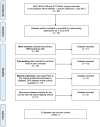Diagnostic testing of pediatric fevers: meta-analysis of 13 national surveys assessing influences of malaria endemicity and source of care on test uptake for febrile children under five years
- PMID: 24748201
- PMCID: PMC3991688
- DOI: 10.1371/journal.pone.0095483
Diagnostic testing of pediatric fevers: meta-analysis of 13 national surveys assessing influences of malaria endemicity and source of care on test uptake for febrile children under five years
Abstract
Background: In 2010, the World Health Organization revised guidelines to recommend diagnosis of all suspected malaria cases prior to treatment. There has been no systematic assessment of malaria test uptake for pediatric fevers at the population level as countries start implementing guidelines. We examined test use for pediatric fevers in relation to malaria endemicity and treatment-seeking behavior in multiple sub-Saharan African countries in initial years of implementation.
Methods and findings: We compiled data from national population-based surveys reporting fever prevalence, care-seeking and diagnostic use for children under five years in 13 sub-Saharan African countries in 2009-2011/12 (n = 105,791). Mixed-effects logistic regression models quantified the influence of source of care and malaria endemicity on test use after adjusting for socioeconomic covariates. Results were stratified by malaria endemicity categories: low (PfPR2-10<5%), moderate (PfPR2-10 5-40%), high (PfPR2-10>40%). Among febrile under-fives surveyed, 16.9% (95% CI: 11.8%-21.9%) were tested. Compared to hospitals, febrile children attending non-hospital sources (OR: 0.62, 95% CI: 0.56-0.69) and community health workers (OR: 0.31, 95% CI: 0.23-0.43) were less often tested. Febrile children in high-risk areas had reduced odds of testing compared to low-risk settings (OR: 0.51, 95% CI: 0.42-0.62). Febrile children in least poor households were more often tested than in poorest (OR: 1.63, 95% CI: 1.39-1.91), as were children with better-educated mothers compared to least educated (OR: 1.33, 95% CI: 1.16-1.54).
Conclusions: Diagnostic testing of pediatric fevers was low and inequitable at the outset of new guidelines. Greater testing is needed at lower or less formal sources where pediatric fevers are commonly managed, particularly to reach the poorest. Lower test uptake in high-risk settings merits further investigation given potential implications for diagnostic scale-up in these areas. Findings could inform continued implementation of new guidelines to improve access to and equity in point-of-care diagnostics use for pediatric fevers.
Conflict of interest statement
Figures




Similar articles
-
Effect of diagnostic testing on medicines used by febrile children less than five years in 12 malaria-endemic African countries: a mixed-methods study.Malar J. 2015 May 10;14:194. doi: 10.1186/s12936-015-0709-0. Malar J. 2015. PMID: 25957881 Free PMC article.
-
Folic acid supplementation and malaria susceptibility and severity among people taking antifolate antimalarial drugs in endemic areas.Cochrane Database Syst Rev. 2022 Feb 1;2(2022):CD014217. doi: 10.1002/14651858.CD014217. Cochrane Database Syst Rev. 2022. PMID: 36321557 Free PMC article.
-
Diagnosis and Treatment of the Febrile Child.In: Black RE, Laxminarayan R, Temmerman M, Walker N, editors. Reproductive, Maternal, Newborn, and Child Health: Disease Control Priorities, Third Edition (Volume 2). Washington (DC): The International Bank for Reconstruction and Development / The World Bank; 2016 Apr 5. Chapter 8. In: Black RE, Laxminarayan R, Temmerman M, Walker N, editors. Reproductive, Maternal, Newborn, and Child Health: Disease Control Priorities, Third Edition (Volume 2). Washington (DC): The International Bank for Reconstruction and Development / The World Bank; 2016 Apr 5. Chapter 8. PMID: 27227231 Free Books & Documents. Review.
-
Malaria Rapid Tests, Febrile Illness Management, and Child Mortality Across Sub-Saharan African Countries.JAMA. 2024 Oct 15;332(15):1270-1281. doi: 10.1001/jama.2024.12589. JAMA. 2024. PMID: 39292453
-
Estimating the number of paediatric fevers associated with malaria infection presenting to Africa's public health sector in 2007.PLoS Med. 2010 Jul 6;7(7):e1000301. doi: 10.1371/journal.pmed.1000301. PLoS Med. 2010. PMID: 20625548 Free PMC article.
Cited by
-
Quality of clinical management of children diagnosed with malaria: A cross-sectional assessment in 9 sub-Saharan African countries between 2007-2018.PLoS Med. 2020 Sep 14;17(9):e1003254. doi: 10.1371/journal.pmed.1003254. eCollection 2020 Sep. PLoS Med. 2020. PMID: 32925906 Free PMC article.
-
Beyond 'test and treat' - malaria diagnosis for improved pediatric fever management in sub-Saharan Africa.Glob Health Action. 2016 Dec 16;9:31744. doi: 10.3402/gha.v9.31744. eCollection 2016. Glob Health Action. 2016. PMID: 27989273 Free PMC article.
-
Principles, practices and knowledge of clinicians when assessing febrile children: a qualitative study in Kenya.Malar J. 2017 Sep 20;16(1):381. doi: 10.1186/s12936-017-2021-7. Malar J. 2017. PMID: 28931399 Free PMC article.
-
Improving prescribing practices with rapid diagnostic tests (RDTs): synthesis of 10 studies to explore reasons for variation in malaria RDT uptake and adherence.BMJ Open. 2017 Mar 8;7(3):e012973. doi: 10.1136/bmjopen-2016-012973. BMJ Open. 2017. PMID: 28274962 Free PMC article.
-
Effect of diagnostic testing on medicines used by febrile children less than five years in 12 malaria-endemic African countries: a mixed-methods study.Malar J. 2015 May 10;14:194. doi: 10.1186/s12936-015-0709-0. Malar J. 2015. PMID: 25957881 Free PMC article.
References
-
- World Health Organization (2000) The use of anti-malarial drugs: report of a WHO informal consultation. Geneva: World Health Organization.
-
- Källander K, Nsungwa-Sabiiti J, Peterson S (2004) Symptom overlap for malaria and pneumonia – policy implications for home management strategies. Acta Trop 90: 211–4. - PubMed
-
- World Health Organization (2010) Guidelines for the treatment of malaria. Geneva: World Health Organization.
Publication types
MeSH terms
Grants and funding
LinkOut - more resources
Full Text Sources
Other Literature Sources
Medical

